Guest geology lesson by David Middleton
PETM = Paleocene-Eocene Thermal Maximum

Research Article
Temporal Scaling of Carbon Emission and Accumulation Rates: Modern Anthropogenic Emissions Compared to Estimates of PETM Onset Accumulation
Philip D. Gingerich
First published: 30 January 2019[…]
Plain Language Summary
American Geohysterical Union
The Paleocene‐Eocene thermal maximum (PETM) is a global greenhouse warming event that happened 56 million years ago, causing extinction in the world’s oceans and accelerated evolution on the continents. It was caused by release of carbon dioxide and other greenhouse gases to the atmosphere. When we compare the rate of release of greenhouse gases today to the rate of accumulation during the PETM, we must compare the rates on a common time scale. Projection of modern rates to a PETM time scale is tightly constrained and shows that we are now emitting carbon some 9–10 times faster than during the PETM. If the present trend of increasing carbon emissions continues, we may see PETM‐magnitude extinction and accelerated evolution in as few as 140 years or about five human generations.
H/T to Jack Dale for this gem.
Gingerich, 2019 is a recent paper reiterating the PETM Chicken Little of the Sea meme. In the comments section of a recent post, it was cited as evidence of imminent catastrophe and followed up by a comment featuring this image from Clean Tecnica:
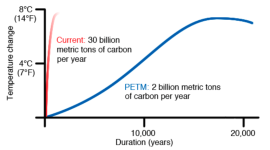
Figure 1. Earth should already be Venus.
I just had to track this back to the Clean Tecnica article… Their scientific prowess is almost always laughable… And I was not disappointed.
Atmosphere Absorbing CO2 Faster Than PETM, When Dinosaurs PerishedMarch 22nd, 2016 by Sandy Dechert
A new study in Nature Geoscience, led by Richard Zeebe of the University of Hawaii, looked at an anomalous time period called the Palaeocene-Eocene Thermal Maximum, or PETM. This phenomenon occurred about 56 million years ago, about ten million years following the beginning of the Cenozoic era (Age of Mammals), just about when the dinosaurs became extinct.
During the PETM, concentrations of carbon dioxide in the atmosphere spiked by 5 degrees Celsius, far higher than they have risen since human preindustrial levels 200 years ago. Climate scientists and world policy makers agree that 2 degrees more is all humans can probably take—or maybe 1.5, as more cautious voices are warning.
[…]
The investigation indicates that earth’s population now is emitting carbon into the atmosphere faster than carbonization at any other time in earth’s history since the PETM. Zeebe explains:
“If you look over the entire Cenozoic, the last 66 million years, the only event that we know of at the moment, that has a massive carbon release, and happens over a relatively short period of time, is the PETM. We actually have to go back to relatively old periods, because in the more recent past, we don’t see anything comparable to what humans are currently doing.”
In fact, our current rate of anthropogenic carbon release is at least an order of magnitude (10x) higher than what the world experienced during the PETM. The study concludes that “given that the current rate of carbon release is unprecedented throughout the Cenozoic, we have effectively entered an era of a no-analogue state.” In other words, earth has apparently never seen a situation like today’s for at least 66 million years, if ever. At that time, the hothouse world lasted over 1,000 centuries.
Clean Tecnica
What journalistic skills!
This phenomenon occurred about 56 million years ago, about ten million years following the beginning of the Cenozoic era (Age of Mammals), just about when the dinosaurs became extinct.
The PETM wasn’t “just about when the dinosaurs became extinct.” 10 million years later is not “just about when.” The K-T (or K-Pg) mass extinction wiped out 75% of all species on Earth, according to some estimates, taking out entire taxonomic genera and families, while putting serious dents into some orders and classes.
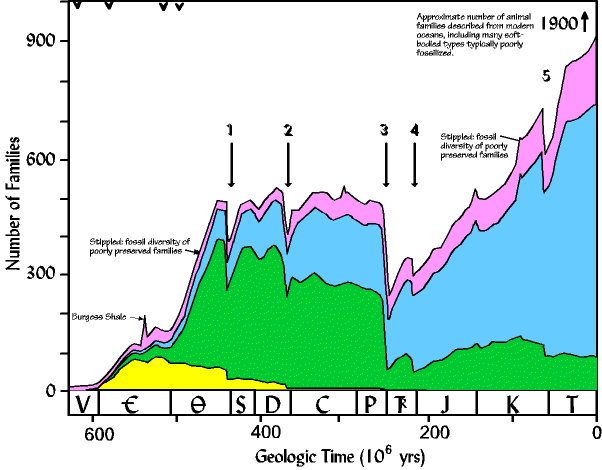
Figure 2. The five real mass extinction events are numbered 1-5. Each is accompanied by a sharp drop in marine biodiversity. Cambrian fauna = yellow, Paleozoic fauna = green, Modern fauna = blue, and soft bodied organisms = purple. Note the total lack of a dip anywhere in the Tertiary Period. “Redrawn from Sepkoski, J.J. Jr, 1984, A kinetic model of Phanerozoic taxonomic diversity, III. Post Paleozoic families and mass extinctions: Paleobiology 10:246-267.” SEPM Strata
Apart from the mostly temporary extinction of some benthic foraminifera, the PETM was a period of thriving biodiversity.

Figure 3. Cenozoic biodiversity of Amazonia (Hoorn et al., 2010). Rain forests must like “ocean acidification.”
This is one of the most priceless quotes ever…
During the PETM, concentrations of carbon dioxide in the atmosphere spiked by 5 degrees Celsius…
Sandy Dechert, you earned a zillion Billy Madison’s for this!
Zeebe et al., 2016 is actually a well-done bit of research, apart from the uber-alarmist title, Anthropogenic carbon release rate unprecedented during the past 66 million years… Lions and tigers and bears! Anthony covered it in this 2016 post here on WUWT.
Let’s just accept in arguendo that the modern rate of carbon release to the atmosphere and oceans is actually unprecedented in 66 million years… So what?
Almost all of the effect of CO2 on temperature and seawater pH is essentially instantaneous. The Transient Climate Response (TCR) is coincident with the rise in CO2. TCR is >80% of the total warming effect. The remaining <20% occurs over hundreds of years, where it will be in the “noise level.”
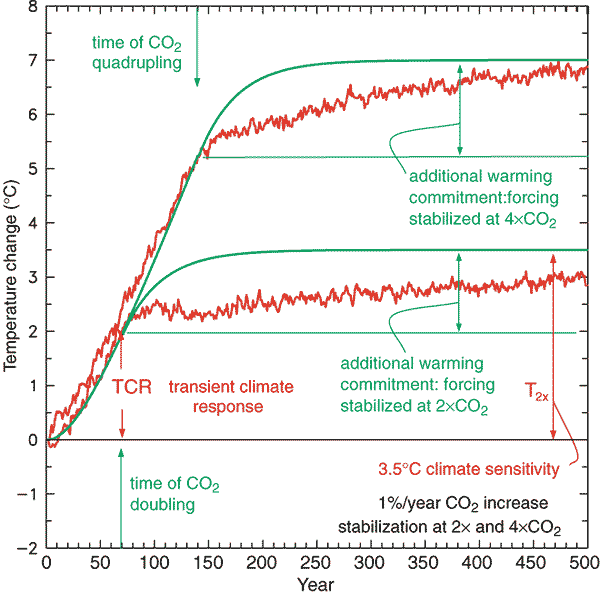
Figure 4. TAR Climate Change 2001: The Scientific Basis, IPCC
Seawater pH is a function of Dissolved Inorganic Carbon (DIC, ΣCO2) and Total Alkalinity (TA).
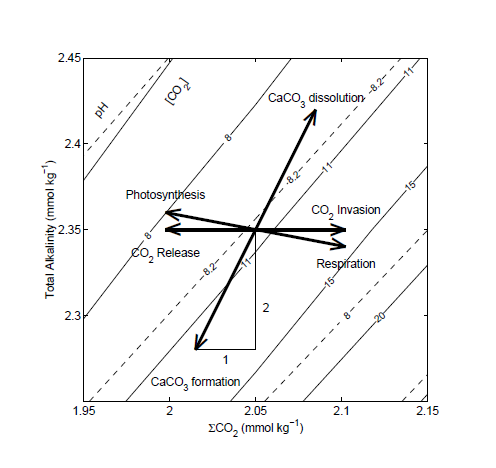
Figure 5. ΣCO2, TA and pH. (Zeebe and Wolf-Galdrow)
ΣCO2 (DIC) and TA are “conservative quantities,” unaffected by changes in pressure and temperature and can be calculated if any two of two of the following parameters: pCO2, pH (not pH) and ΣCO2, and the total dissolved boron are known.
ΣCO2 = [CO2]+[HCO3–]+[CO32-]
TA = [HCO3–]+ 2[CO32-]+[B(OH)4–]+[OH–]-[H+]
This process is also basically instantaneous.

Figure 6. TA and DIC vs CO2
A study of seawater pH near active volcanic CO2 vents in the Mediterranean (Kerrison et al., 2011) found that the pH immediately adjacent to the vent was still alkaline, despite being subjected to the equivalent of nearly 5,600 ppm CO2.
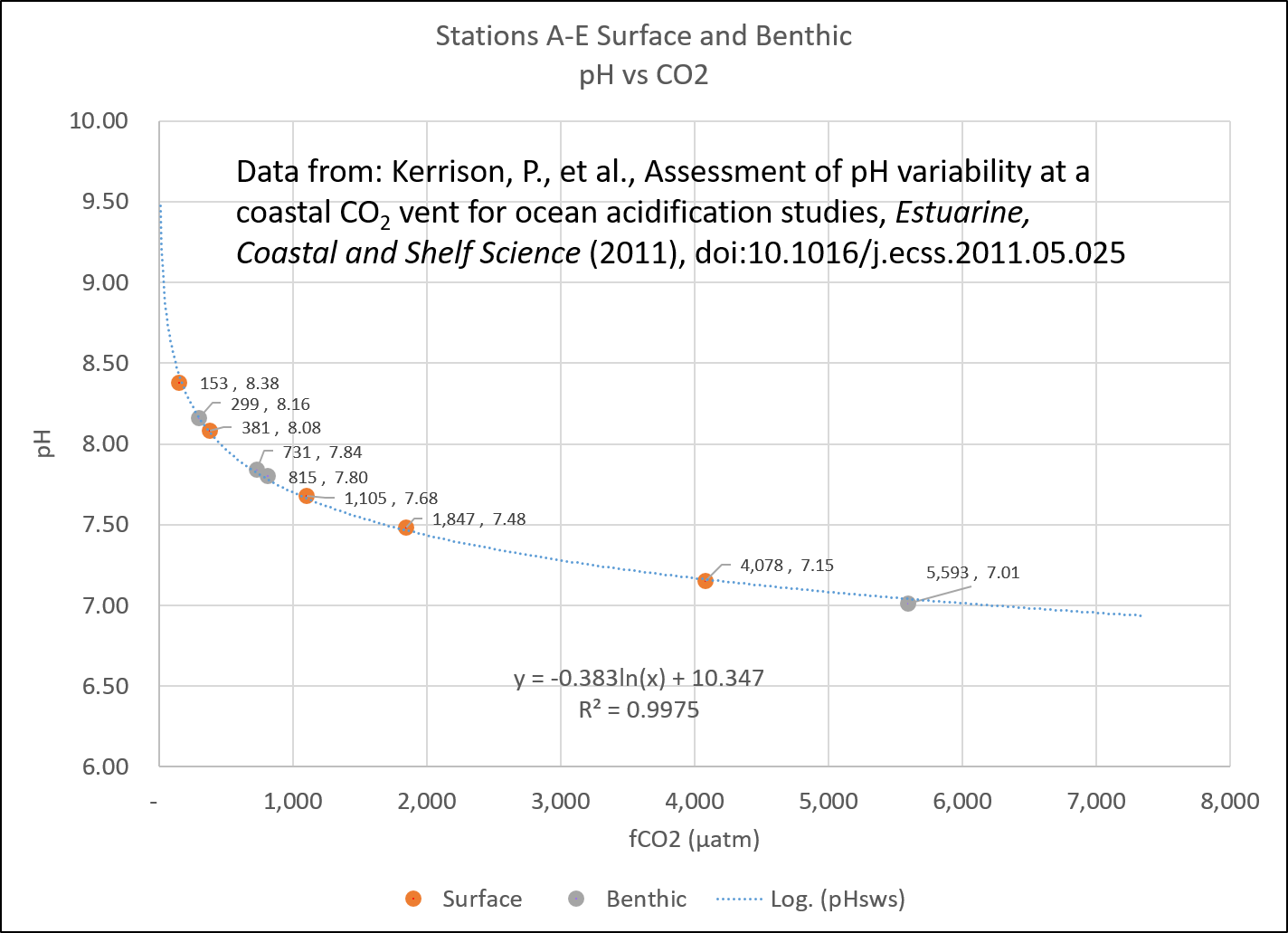
Figure 7. Seawater pH vs CO2
Partial pressure and fugacity (μatm) are a little lower than what the mixing ratio (ppm) would be, depending on temperature and humidity. However, they are close. A partial pressure (pCO2) of 350 μatm generally equates to about 350 ppm in the atmosphere. At nearly 5,600 ppm CO2 the seawater was still alkaline, not acidic.
Even if anthropogenic carbon emissions are “unprecedented during the past 66 million years,” it’s clear that comparisons to the PETM are, at best, irrelevant and, at worst, intentionally misleading.
Our “unprecedented” carbon emissions will probably push atmospheric CO2 to anywhere from 500 to 700 ppm by the end of this century. Based on a real world “business as usual” emissions scenario, with oil consumption peaking around 2060, coal consumption remaining relatively stable, natural gas displacing oil at its current pace and no carbon tax, I come up with a CO2 level right about inline with RCP 6.0, “a mitigation scenario, meaning it includes explicit steps to combat greenhouse gas emissions (in this case, through a carbon tax)“.

Figure 8. RCP 8.5, Part Deux: “The stuff nightmares are made from.”
A realistic TCR of 1.5 °C per doubling of CO2 yields about 2 °C of warming at 700 ppm, half of which has already occurred.
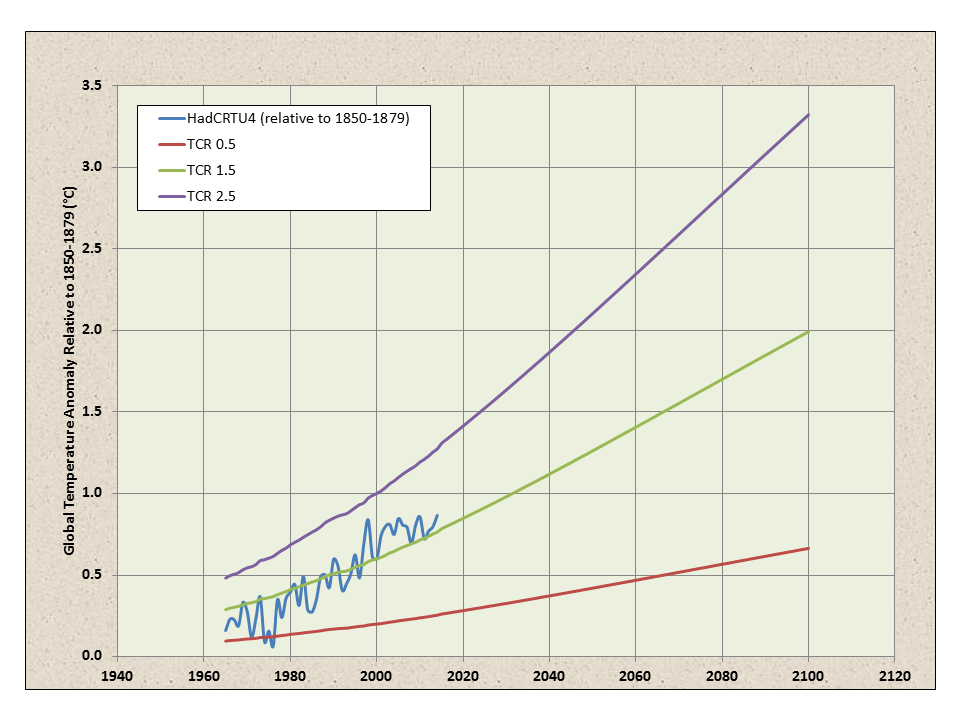
Figure 9. A real world (this world, not Venus) “business as usual” scenario would barely nudge the dreaded 2 °C limit by the year 2100… Assuming that all of the warming since 1850 is due to greenhouse forcing…9 Which it isn’t.
Contrasting the “Anthropocene” (fake word) with the PETM (real acronym)
The PETM was probably related to the formation of the North Atlantic Large Igneous Province (Storey et, al 2007), a period of intense volcanic activity associated with the opening of the North Atlantic Ocean.
PETM atmospheric CO2 could have been anywhere from 400-800 to over 3,000 ppm. The Mauna Loa CO2 time series (MLO) doesn’t even break out of the Neogene noise level.

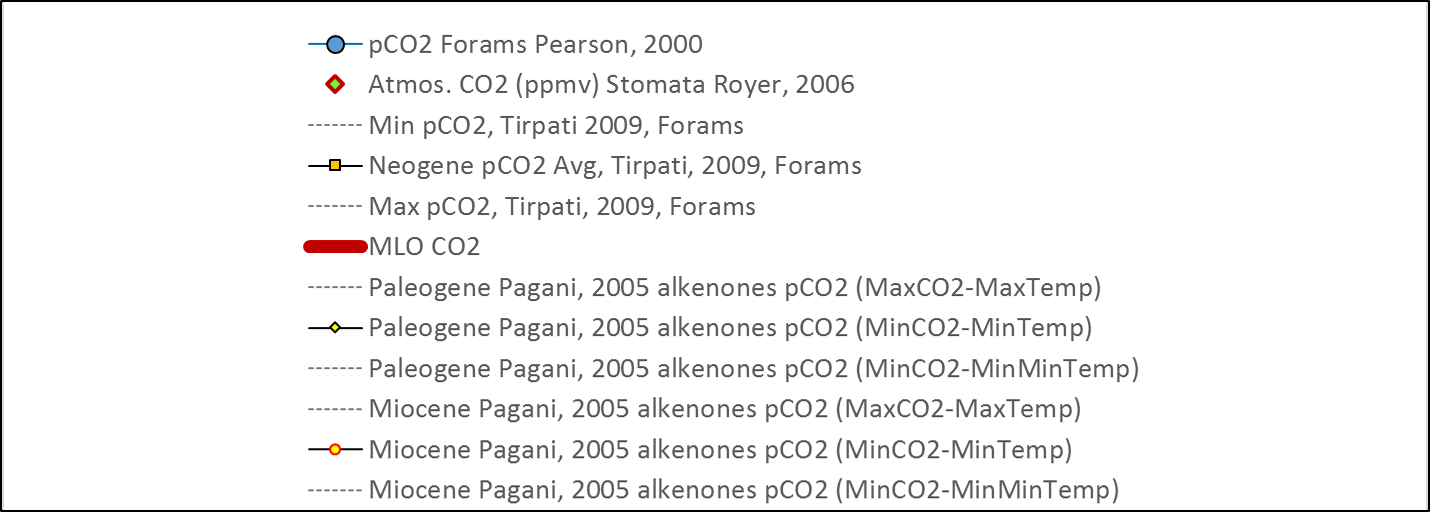
Figure 10. Cenozoic CO2 atmospheric mixing ratio and seawater partial pressure. Notice the huge difference between atmospheric CO2 and pCO2. Also notice that pCO2 was higher before and after the PETM and that stomata data indicate that CO2 was about what it is today, apart from a short duration spike to about 800 ppmv 55.2 Mya. Talk about settled science! Note: Older is to the right. Tirpati should be Tripati
Note how the PETM (55 Ma) is about as far from a CO2 analog to modern times as it possibly could be… unless the PETM stomata data are correct, in which case AGW is even more insignificant than previously thought.
Regarding temperatures, the PETM is also about as far from being an analog to modern times as it possibly could be.

Figure 11. High latitude SST (°C) From benthic foram δ18O. Funny how the PETM is often cited as a nightmarish version of a real-world RCP8.5… While the warmer EECO is a climatic optimum. (Zachos et al., 2001). Note: Older is to the right.
Note that the Early Eocene Climatic Optimum (EECO) was just as warm as the PETM and lasted longer.
To demonstrate how utterly ridiculous it is to describe the PETM as an analog for modern climate change, we just have to look at the Miocene Epoch, which was much cooler than the PETM and EECO.

Figure 12. High latitude SST (°C) From benthic foram δ18O (Zachos, et al., 2001) and HadSST3 (Hadley Centre / UEA CRU via http://www.woodfortrees.org) plotted at same scale, tied at 1950 AD. Note: older is to the left.
Bear in mind that the HadSST3 data are of much higher resolution than the δ18O time series. The amplitude of the proxy time series on multi-decadal to centennial time-scales should be considered to be the minimum of the true variability on those time-scales, due to the much lower resolution than the instrumental data (Ljungqvist, F.C. 2010). Despite this, the modern ~1 °C rise since pre-industrial times doesn’t even break out of the Pleistocene noise level… another 1 °C rise won’t even break out of the Pleistocene noise level.
The PETM is also often cited as an analog for Chicken Little of the Sea…

Figure 13. Cenozoic seawater pH from boron isotopes in planktonic foraminifera (modified after Pearson & Palmer, 2000). Note that pH was lower than the PETM 51.5 (EECO) and 59.5 Ma. Note: Older is to the right. Modern pH data (HOTS, Dore et al., 2009) are posted for comparison. As with temperatures, the amplitude of the proxy time series on multi-decadal to centennial time-scales should be considered to be the minimum of the true variability on those time-scales, due to the much lower resolution than the instrumental data.
There simply is no analogy. The paleogeography of the Cretaceous through the Eocene “Hot House Climate” was very different than the “Ice Age Climate” since the early Oligocene. The warmth of the PETM was mostly a function of plate tectonics.
The phrase “ocean acidification” was literally invented out of thin air in 2003 by Ken Caldiera. The relationship between CO2, DIC, TA and the distribution of pelagic sediments has been understood for a long time.
When the pH of seawater decreases, calcium carbonate dissolves. In warm, shallow seas, at a pH of about 8.3, dissolution of aragonite and calcite particles by inorganic processes is almost nonexistent. However, since the classical studies of the Challenger expedition, it has been known that the proportion of calcium-carbonate particles in seafloor sediments decreases as depth of water increases (Table 5-1). Such decrease is particularly rapid at depths between 4000 and 6000 m. Although the reasons for this decrease have been debated, the evidence suggests that calcium carbonate dissolves because the CO2 concentration increases with depth. The control on CO2 appears to be part biological; it results from biological oxidation of organic-carbon compounds. Also, the water masses at greater depth were derived from the polar region; their temperature is lower and the water contains more dissolved CO2. Increased concentration of CO2 is in turn reflected by lower pH, which leads to calcium carbonate dissolution. However, the increase of pressure with depth may also be involved; such increase affects the dissociation of carbonic acid (Eqs. 5-11 and 5-12). The depth at which the calcium-carbonate decreases most rapidly is known as the carbonate-compensation depth, defined as the depth at which the rate of dissolution of solid calcium carbonate equals the rate of supply.
Friedman and Sanders, pages 133-134. (1978)
Prior to Chicken Little of the Sea, the phrase was “shoaling of the lysocline” (a shallowing of the carbonate or calcite compensation depth).
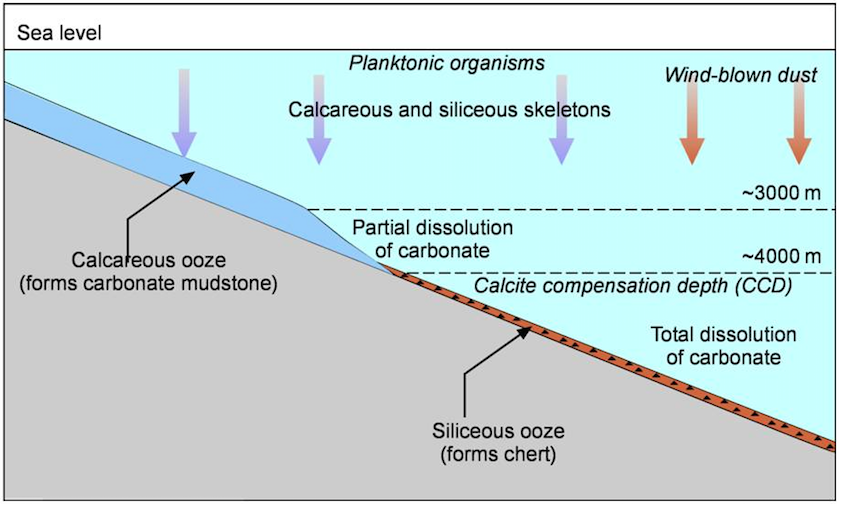
Figure 14. “Schematic cross section of the ocean showing different depositional zones based on the calcite compensation depth (Nichols, 2009).” WVU GEOL 616
The PETM exhibited a genuine shoaling of the lysoline.
During Ocean Drilling Program Leg 208, six sites were drilled at water depths between 2500 and 4770 m to recover lower Cenozoic sediments on the northeastern flank of Walvis Ridge. Previous drilling in this region (Deep Sea Drilling Project [DSDP] Leg 74) recovered pelagic oozes and chalk spanning the Cretaceous/Paleogene (K/P), Paleocene/Eocene, and Eocene/Oligocene boundaries. The objective of Leg 208 was to recover intact composite sequences of these “critical” transitions from a wide range of depths. Multichannel seismic data (Meteor Cruise M49/1) along with information from DSDP Leg 74 sites were used to identify sites where continuous sequences of lower Cenozoic sediment should be present. Double to triple advanced piston coring, occasional extended core barrel coring to deepen the holes, and high-resolution physical property measurements were employed to construct “composite sections.” The composite sections provide a detailed history of paleoceanographic variation associated with several prominent episodes of early Cenozoic climate change, including the K/P boundary, the Paleocene/Eocene Thermal Maximum (PETM), the early Eocene Climatic Optimum, and the early Oligocene Glacial Maximum.The PETM interval, the main focus of Leg 208, was recovered at five sites along a depth transect of 2.2 km. The sediment sequence is marked by a red clay layer, which varies in thickness from 20 to 50 cm from site to site, within a thick and uniform sequence of upper Paleocene and lower Eocene foraminifer-bearing nannofossil ooze. The basal color contact is relatively sharp, although magnetic susceptibility data show a more gradual, steplike transition at the deeper Sites 1262 and 1267. The carbonate content drops to 0 wt% at all sites except for Site 1265. The upper contact is gradational in the shallow sites and relatively sharp at the deeper sites. Overlying the clay layer is a sequence of nannofossil ooze, which is slightly richer in carbonate than the unit immediately underlying the clay layer.
The depth transect permits testing of the leading hypothesis for the cause of the PETM: the abrupt dissociation of as much as 2000 Gt of marine methane hydrate. Numerical modeling demonstrates that the injection of such a large mass of carbon to the ocean/atmosphere could have triggered a rapid (~10 k.y.) global shoaling of the calcite compensation depth (CCD) and lysocline, followed by a gradual recovery, and “overcompensation” with the CCD overshooting pre-excursion depths. Based on sediment cores recovered during Leg 208, the CCD shoaled by >2 km during the excursion, considerably more than predicted in present carbon cycle models of the event.
Leg 208 material also documents biotic responses to environmental changes as a result of the methane release and CCD shoaling (e.g., severe dissolution over such a large depth range may well have been an important factor in the benthic foraminiferal extinction event coincident with the base of the clay layer at every site, and nannofossils showed a short-term relative abundance response from Fasciculithus to Zygrhablithus). Planktonic foraminifers are heavily dissolved in the clay layer with only extremely rare specimens of acarinids and morozovellids remaining.
The Leg 208 transect complements a transect drilled on the southern Shatsky Rise during Leg 198, a deep latitudinal transect in the equatorial Pacific drilled during Leg 199, a shallow to bathyal transect drilled on Demarera Rise during Leg 207, and a depth transect proposed for future drilling in the western North Atlantic Ocean (J-Anomaly Ridge and southeast Newfoundland Rise).
ODP Leg 208 Summary
The shoaling of the lysocline during the PETM is represented by the 30 cm thick band of red clay from 13.4 to 13.7 m on the lithology column in figure 15. When the lysocline and carbonate compensation depth (CCD) briefly shoaled, the transition from calcareous to siliceous ooze moved shoreward. When the CCD dropped back down to its pre-PETM depth, the transition from calcareous to siliceous ooze moved seaward… Leaving a 30 cm thick layer of red clay in the middle of a thick marl sequence. Rising and falling sea level could have left a similar layer of red clay.
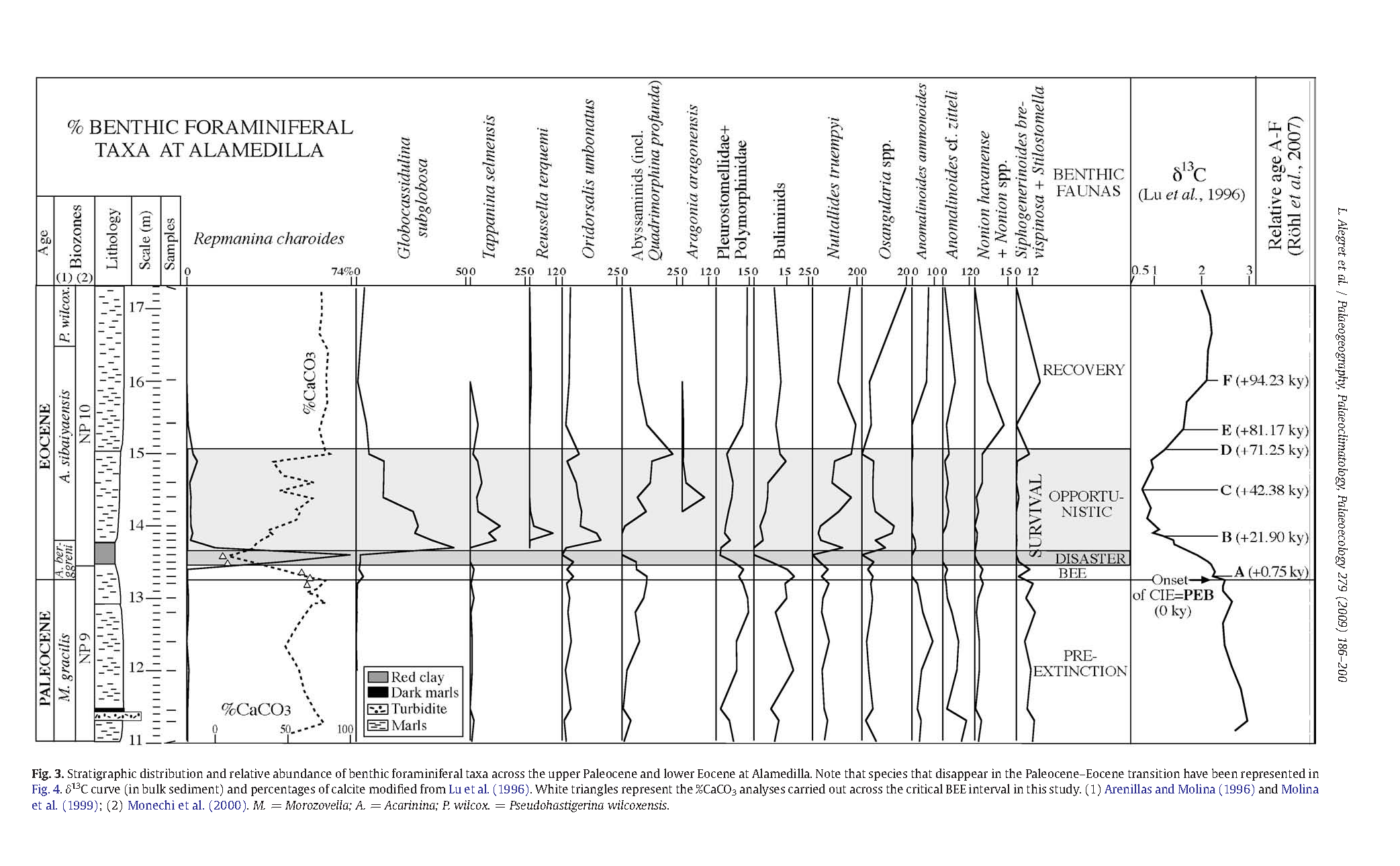
Figure 15. This provides an entirely different perspective on the word extinction. Alegret, L., S. Ortiz & E. Molina. Extinction and recovery of benthic foraminifera across the Paleocene–Eocene Thermal Maximum at the Alamedilla section (Southern Spain). Palaeogeography, Palaeoclimatology, Palaeoecology 279 (2009) 186–200
The benthic foram’s above and below the red clay horizon ceased to exist at that location for about 70,000 to 220,000 years. However, the fact that at least some of them returned to that location after the PETM might indicate that the benthic foram “mass extinction” was more of a benthic foram depositional “mass relocation,” rather than a true extinction.
The PETM lysocline shoaled by more than 2,000 m at Walvis Ridge… This is literally written in stone.
Over the past 250 years, since the beginning of the industrial revolution, there has been about a 16% decrease in aragonite and calcite saturation state in the Pacific Ocean. From repeat oceanographic surveys, we have observed an average 0.34% yr−1 decrease in the saturation state of surface seawater with respect to aragonite and calcite over a 14‐year period. This has caused an upward migration of the aragonite and calcite saturation horizons toward the ocean surface on the order of 1–2 m yr−1. These changes are the result of the uptake of anthropogenic CO2 by the oceans, as well as other smaller scale regional changes in circulation over decadal time scales. If CO2 emissions continue as projected out to the end this century, the resulting changes in the marine carbonate system would mean that many coral reef systems in the Pacific would probably no longer be able to maintain the necessary rate of calcification required to sustain their vitality.
Feely et al., 2012
The 16% decrease in aragonite and calcite saturation state in the Pacific Ocean over the past 250 years is entirely based on calculating the preindustrial aragonite and calcite from the assumed preindustrial atmospheric CO2 concentration. It is circular reasoning. Regarding the claim that they’ve measured 14-28 m of shoaling over a 14-year period… That’s not even the margin of error in estimating the CCD. A genuine shoaling of the lysocline would cause a redistribution of pelagic (open ocean seafloor) sediments.
I have not been able to locate a more recent version of this map:
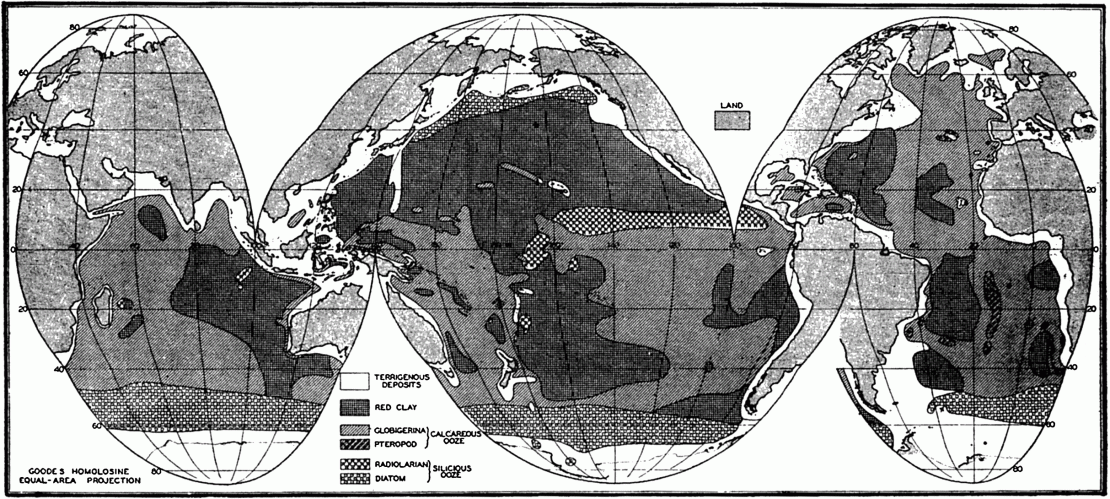
DISTRIBUTION OF PELAGIC SEDIMENTS
General Features of Distribution. Figure 253 shows the distribution of the various types of pelagic sediments. The representation is generalized partly to avoid confusion and partly because of the incomplete knowledge as to the types of sediments found in many parts of the oceans. Any such presentations of the distribution of pelagic sediments are modified versions of maps originally prepared by Sir John Murray and his associates. Further investigations have changed the boundaries but have not materially affected the general picture. The figure has been prepared from the most recent sources available. The distribution of sediments in the Indian Ocean is based on a map by W. Schott (1939a), that in the Pacific Ocean is from W. Schott in G. Schott (1935), with some revisions based on Revelle’s studies of the samples collected by the Carnegie (Revelle, 1936). The data for the Atlantic have been drawn from a number of sources, since no comprehensive map has been prepared for many years. The Meteormaterial has been described by Correns (1937 and 1939) and Pratje (1939a). Thorp’s report (1931) on the sediments of the Caribbean and the western North Atlantic was used for those areas, and Pratje’s data (1939b) for the South Atlantic were supplemented by those of Neaverson (1934) for the Discovery samples. The distribution in the North Atlantic is from Murray (Murray and Hjort, 1912).One type of shading has been used for all of the calcareous sediments and another for the siliceous sediments. Unless the symbol P is shown to indicate that the area is covered with pteropod ooze, it is to be understood that the calcareous sediment is globigerina ooze. The siliceous organic sediments are indicated as D for diatom ooze and Rfor radiolarian ooze. The unshaded areas of the oceans and seas are covered with terrigenous sediments.
[…]
Sverdrup, Johnson & Fleming, 1942
The PETM resulted in a major redistribution of pelagic sediments. If Chicken Little of the Sea is like the PETM, the seafloor would exhibit a significant redistribution of pelagic sediments relative to 1942. More of the seafloor would be covered with siliceous ooze and far less would be covered by calcareous ooze. If anyone is aware of a recent map, like the one in my marine science text book, please let me know.
References
Colosimo, A.B, Bralower, T.J., and Zachos, J.C., 2006. “Evidence for
lysocline shoaling at the Paleocene/Eocene Thermal Maximum on Shatsky
Rise, northwest Pacific”. In Bralower, T.J., Premoli Silva, I., and Malone, M.J. (Eds.), Proc. ODP, Sci. Results, 198, 1–36
Dore, J.E., Lukas R., Sadler, D.W. Church, M.J., Karl, D.M. (2009). “Physical and biogeochemical modulation of ocean acidification in the central North Pacific.” Proc Natl Acad Sci USA 106:12235–12240.
Friedman, G.M. and Sanders, J.E. (1978) “Principles of Sedimentology”. Wiley, New York.
Gingerich, Philip. (2019). “Temporal Scaling of Carbon Emission and Accumulation Rates: Modern Anthropogenic Emissions Compared to Estimates of PETM-Onset Accumulation”. Paleoceanography and Paleoclimatology. 10.1029/2018PA003379. Abstract only.
Hoorn, C., Wesselingh, F.P., ter Steege, H.; Bermudez, M.A., Mora, A., Sevink, J., Sanmartin, I., Sanchez-Meseguer, A., Anderson, C.L., Figueiredo, J.P., et al. “Amazonian through time: Andean uplift,climate change, landscape evolution and biodiversity”. Science 2010, 330, 927–931
Kerrison, Phil & Hall-Spencer, Jason & Suggett, David & Hepburn, Leanne & Steinke, Michael. (2011). “Assessment of pH variability at a coastal CO2 vent for ocean acidification studies.” Estuarine and Coastal Marine Science. 94. 129-137. 10.1016/j.ecss.2011.05.025.
Pagani, M., J.C. Zachos, K.H. Freeman, B. Tipple, and S. Bohaty. 2005. “Marked Decline in Atmospheric Carbon Dioxide Concentrations During the Paleogene”. Science, Vol. 309, pp. 600-603, 22 July 2005.
Pearson, P. N. and Palmer, M. R.: Atmospheric carbon dioxide concentrations over the past 60 million years, Nature, 406, 695–699,https://doi.org/10.1038/35021000, 2000.
Royer, et al., 2001. Paleobotanical Evidence for Near Present-Day Levels of Atmospheric CO2 During Part of the Tertiary. Science 22 June 2001: 2310-2313. DOI:10.112
Storey, Michael, Robert A. Duncan, Carl C Swisher 2007. “Paleocene-Eocene Thermal Maximum and the Opening of the Northeast Atlantic”. Science 27 April 2007: 587-589. DOI:10.1126
Sverdrup, H. U. M. W., Johnson and R. H. Fleming, “The Oceans—Their Physics, Chemistry, and General Biology,” Prentice-Hall, Upper Saddle River, 1942.
Tripati, A.K., C.D. Roberts, and R.A. Eagle. 2009. “Coupling of CO2 and Ice Sheet Stability Over Major Climate Transitions of the Last 20 Million Years”. Science, Vol. 326, pp. 1394 1397, 4 December 2009. DOI: 10.1126/science.1178296
Zachos, J. C., Pagani, M., Sloan, L. C., Thomas, E. & Billups, K. “Trends, rhythms, and aberrations in global climate 65 Ma to present”. Science 292, 686–-693 (2001).
Zachos, J.C., Kroon, D., Blum, P., et al., 2004. Proc. ODP, Init. Repts., 208: College Station, TX (Ocean Drilling Program). doi:10.2973/odp.proc.ir.208.2004
Zachos, et al., 2005. “Rapid Acidification of the Ocean During the Paleocene-Eocene Thermal Maximum”. Science 10 June 2005: 1611-1615. DOI:10.1126
Zeebe, R. E., A. Ridgwell, and J. C. Zachos (2016), “Anthropogenic carbon release rate unprecedented during the past 66 million years”. Nat. Geosci., 9(4), 325–329, doi:10.1038/ngeo2681.
Zeebe, Richard E. and Dieter A. Wolf-Gladrow CARBON DIOXIDE, DISSOLVED (OCEAN)
Watts Up With That? Chicken Little of the Sea/PETM posts by David Middleton
Ocean Acidification: Chicken Little of the Sea Strikes Again
Chicken Little of the Sea Visits Station ALOHA
The Total Myth of Ocean Acidification
The Total Myth of Ocean Acidification, Part Deux: The Scientific Basis
Chicken Little of the Sea Is Dissolving the Sea Floor!!! Run Away!!!
What?
[Why?]
[Who?]
[Where?]
[When? .mod]
How?
Over easy.
From the “Plain Language Summary” of the referenced Research Article:
“The Paleocene‐Eocene thermal maximum (PETM) is a global greenhouse warming event that happened 56 million years ago, causing extinction in the world’s oceans and accelerated evolution on the continents. It was caused by release of carbon dioxide and other greenhouse gases to the atmosphere.”
I wonder how the researchers were able to separate cause and effect with such certainty. Is it not just as possible that some other forcing parameter caused the global warming associated with PETM, and one of the RESULTING planetary responses was a large release of CO2 (say, from the Earth’s oceans) into the atmosphere?
Correlation does not equal causation, as has been stated truthfully many times.
Incidentally there was virtually no extinctions. Instead biodiversity increased markedly. Very embarassing. Usually the term “major reorganization” is used to hide this fact.
And… many of the “extinctions” were temporary… 😉
What are the While Cliffs of Dover made of?
…what was CO2 when those critters became so prolific?..and those sediments formed?
A shoaling of the lysocline doesn’t eliminate carbonate deposition. It just moves it toward shallower water.
…and those high CO2 levels not only did not dissolve them….they flourished in massive numbers
The Cretaceous was a period of broad shallow seas. The Austin Chalk, very similar to the White Cliffs of Dover, was deposited in water depths of only about 800′. This is well-above the CCD even at 3,000 ppm CO2.
“(PETM) is a global greenhouse warming event”
CO2 NEVER NEVER NEVER caused any kind of negative event EVER, EVER. Jeez!
The PETM theory of warming produced by massive CO2 from vulcanism is based on the assumption that CO2 warms the earth as proposed in IPCC AGW hypothesis. The temperature/CO2 data suggests otherwise; there was an 8 deg C rise in temperature from the end of the last ice age, accompanied by an increase in CO2 of 100ppm, but since the Industrial Revolution began, there has been an increase of ~1 deg C, accompanied by 130ppm increase in CO2. And the post-glacial increase in CO2 never precedes the temperature change but followed it with a delay of anything from a few hundred to several thousand years. Surely this puts a hole in the AGW hypothesis and suggests that the CO2 increase recorded during the PETM is more likely to have been caused by increased temperature – which could have been caused by the widespread and massive oceanic vulcanism raising the average temperature of the oceans – which would have exhaled the CO2
“During the PETM, concentrations of carbon dioxide in the atmosphere spiked by 5 degrees Celsius, far higher than they have risen since human preindustrial levels 200 years ago. ”
During the last hour the consumption of electricity in London spiked by 25,000 yards. Yeah, that sounds sciency enough for more climate catastrophe drivel. Of course it must be so much easier to make these kinds of definitive measurements if it was millions of years ago.
During the past 15 minutes of reading this article, my IQ has spiked by a negative 3 oranges.
You are Ocasio-Cortez and I claim my $5bn
OH for keyrist sake, ………..
The Age of the Dinosaurs is the period in geologic time from about 252 Mya to about 66 Mya and includes the Triassic, Jurassic and the Cretaceous Periods and which is plainly denoted on this Atmospheric CO2 & Average Global Temperature proxy graph, to wit:
http://www.dandebat.dk/images/1365p.jpg
And as one can easily see, the correlation between the “rise and fall” of atmospheric CO2 pretty much coincides EXACTLY with the “rise and fall” of the Age of the Dinosaurs (252 to 66 Mya)
And the quantity of food required for nourishing and maintaining said “rise of the dinosaurs” was highly dependent upon the INCREASE to 1,600+ ppm of atmospheric CO2 …. and when the CO2 started its DECREASE below 1,600 ppm at around 100 Mya the large herbivore dinosaurs began dying off due to starvation ……. which in turn caused the large carnivore dinosaurs to begin dying off due to starvation.
No asteroid strike needed, ….. lack of atmospheric CO2 did the job.
As cursing was not allowed (and I got modified for it), I’m still in doubt how must bad spelling makes it acceptable. Not complaining, just wondering key* words.
Hint… Schist and frack aren’t technically curse words… 😉
“It (the PETM) was caused by release of carbon dioxide and other greenhouse gases to the atmosphere.”
Oh really? Says who? Can they prove it? If temperatures went up first, and then CO2 went up, how in holy hell could CO2 have “caused” the warming? And even if what you claim were true, what on earth caused this sudden, mysterious “release of carbon dioxide and other gases,” hmmmm? Aliens?
Ancient aliens theory defenders say yes and…
The world is not the same as it was 58 million years ago. The Isthmus of Panama has closed and that has led to the current ice age. link Thus the PETM is in no way an analog for anything we can expect in the future.
Who is that in the illustration – Rooster Little?
CHicken Little, from the movie of the same name.
Climate science is not a serious science. Climate scientists can take an assumption (that the warming during the PETM was caused by the increase in CO2) for which there is zero evidence, and run with it as if it was an established fact, and no referee or editor will dare to challenge that everything depends on an unproven assumption.
In fact the data supporting the increase in CO2 during the PETM is quite weak. It is mainly based on the δ¹³C isotopic excursion, as CO2 proxy data is simply not good enough to know the change in CO2 levels during the PETM. I have examined Beerling & Royer 2011 CO2 data for the Cenozoic, and it is impossible to detect the PETM in the data. Surprisingly CO2 levels were much higher 10 million years later according to their proxies (phytoplankton, stomata, and paleosols). Check their figure 1 and look at 56 Ma. No CO2 increase detectable in the proxies. And at 45 Ma there is almost double CO2 and much higher temperature, and if they think that the CO2 released at the PETM can last 10 Myr in the system they are fooling themselves.
http://www.grandkidzfuture.com/earths-climate/ewExternalFiles/Cenozoic%20CO2%202011.pdf
Yep. The primary evidence is the coincidence of 13C and 18O anomalies… 13C are useful, but not diagnostic.
It is May 18, 2019 in San Rafael, CA. The temperature is 55F. It has been this cold all Spring. Please ship all your unwanted CO2 to my neighborhood. Thanks
There is quite a bit of research on the PETM and the consequences to various ecosystems. Case in point:
https://agupubs.onlinelibrary.wiley.com/doi/10.1029/2018PA003379
Paleoceanography and Paleoclimatology banner
Research Article
Temporal Scaling of Carbon Emission and Accumulation Rates: Modern Anthropogenic Emissions Compared to Estimates of PETM Onset Accumulation
One can take the url of this paper and enter it into a scientific AI research assistant such as https://iris.ai/
In this case it returns 156 related papers at first blush. Then, if one should wish to do so, one can refine the search and continue to expand ones knowledge.
Happy reading!
That article is a joke. The accumulation rate with a resolution of days to months cannot be compared in any meaningful way to an accumulation rate for the PETM that can be measured with a resolution of tens of thousands of years.
We don’t know what caused the PETM and we don’t know its effects and consequences. What we do know is that according to proxies it can’t be identified in CO2 records because it was too short lived. We do know that according to proxies the warming reached temperatures similar to those 10 million years later during the Eocene Optimum, while CO2 levels were less than half (~500 ppm to ~1200 pm) at the Paleocene-Eocene boundary than during the Eocene Optimum 10 Myr later.
And you do know perfectly well from your participation at peakoilbarrel that there are no enough fossil fuels to even approach the increase in CO2 that is believed but hasn’t been demonstrated to have taken place in the PETM.
It is indeed chicken-little science. Produced for immediate consumption during a time when a fashionable believe in catastrophic anthropogenic global warming has taken over an entire field of science. It will be as relevant to future science as all those articles on aether properties or the phlogiston.
The only things that we really “know” are:
1) It was warm.
2) There was a 13C depletion anomaly.
3) The lysocilne (calcite compensation depth) shoaled by 500 to >2,000 m.
4) Biodiversity, particularly on land, was booming.
5) Some benthic foraminfera went “extinct”… Some of which recovered.
6) The North Atlantic Large Igneous province was forming.
7) Atmospheric CO2 could have been anywhere from 400 ppm to >3,000 ppm.
8) The configurations of the ocean basins and continents were more similar to the Cretaceous than the Neogene.
It’s enough to draw up many working hypotheses… but… It must be CO2 because… climate change. (Last sentence = 100% sarcasm)
It seems that Gingerich had a respectable career as a paleontologist, according to Wikipedia. Thirty years as a museum director after which he seemed to fade away, until now. Perhaps this latest bit of “research” is his attempt to become one of the “go-to guys” of climate science. It is a bit sad to see him make a fool of himself with those absurd statements in the abstract. Mass extinction – really?
For 99% of the last 250,000,000 years global temperature has been an est. 15 deg C (27 deg F) warmer than today.
Restated: the normative temperature of Planet Earth for the last quarter of a billion years has been much, much warmer than now.
Again: we live in the Ice Age, a global condition of extreme cold which last occurred during the Permian Epoch prior to the Age of the Dinosaurs.
The idea that a 1 deg C temperature rise from current levels will kill off Life On Earth is utter nonsense disproved by historical fact.
Warmer is Better. Warmer is Normal. Warmer is Preferable. If humanity can warm the planet, then we absolutely should for the sake of Life itself.
+1111000100010001011101000001001100110110100100111111011101110100010011001011000101110000110111111011010000000000000000000000000000000000000000000
Bryan, please write it in decimal form:
42000000000000000000000000000000000000000000
I’m surprised it didn’t wrap to a second (or third) line
But, seeing as posts aren’t adjustable (editable) and don’t appear for hours after initial creation, I simply couldn’t correct for it
Exponential form would be even better: 4.2×10^43.
+/- 3 db, that is.
Gordon Dressler:
Exponential form would be even better: 4.2×10^43.
+/- 3 db, that is.
Is that the accoustic measure of the Big Bang?
Cheers
Mike
The answer to life, the universe and everything.
I’m sorry. This was not on my Bing news feed. Therefore, it is not reality.
I think there should be a concerted effort by everyone to work together at reducing the current atmospheric CO2 quantity of 410 ppm back down to a healthier 180 ppm which would greatly benefit the 7+ billion humans currently living on earth.
Life would be much better for everyone with the cooler temperatures and an abundance of food for everyone to eat which should result in a doubling of the population to 15+ billion humans within the next 150 years,
Can someone explain how this: “the abrupt dissociation of as much as 2000 Gt of marine methane hydrate.” happened? What caused all that methane hydrate to suddenly dissociate? Isn’t there a whole lot of methane hydrate on the floor of the Gulf of Mexico?
If that’s what happened, it was probably related to the intense volcanic activity in the North Atlantic (North Atlantic Large Igneous Province).
https://gkeller.princeton.edu/abstracts/role-volcanism-north-atlantic-igneous-province-petm-events-revealed-mercury-anomalies
Given the warm oceanic waters was there even any methane hydrates?
Good point… The PETM was ~5 C warmer in deep ocean waters than it is today.
Talking about the rate of CO2 change during the PETM is utterly futile. To do that you need to know the amount of CO2 and the time the CO2 increased. We know neither.
We know reasonably well how d13C (the isotope composition of carbon) changed, but to translate that into quantity of CO2 one must know the source of the carbon, since that determines the isotope ratio. There are at least seven or eight different hypotheses about that:
Methane clathrate breakdown
Peatland fires
Oxidation of desiccated marine deposits
Cometary impact
North Atlantic LIP eruptions (direct effect or by contact metamorphosis of organic deposits)
Ocean Turnover
Permafrost melting
Then there is the matter of how long the d13C change took. Virtually all figures you see (usually on the order of several thousand years) are maximum intervals, or rather the shortest time span that is at all discernible in the particular drillcore, profile etc. The shift is actually geologically instantaneous.
Dating such short intervals 56 million years ago is hard. Biostratigraphic dating has difficulties even discerning 100,000 year long intervals and the shortest Milankovich cycle that could be used for correlation is 19,000-23,000 years.
One indisputable fact is that all single foraminifera that have ever been measured from this interval have either low or high d13c values. Not a single individual with intermediate values have ever been found. This means either that the shift was very fast or that every last foram from the period of the change has failed to fossilize.
The only claimed true, direct dating of the shift is based on a clay rhytmite from New Jersey where the shift happens over 13 layers. If the layers are annual as claimed the shift must have been truly instantaneous, since 13 years is about right for an instantaneous atmospheric carbon isotope change to show up in shallow marine deposits as shown by the “bomb pulse”. That implies a cometary impact or, just possibly, a single huge volcanic eruption.
The best stratigraphic bracketing of the shift I know of is from the Schöningen lignite deposit in Germany. The whole PETM (c. 150,000 years) is 10 meters thick there, and the entire d13C shift happens between two samples 8 cm apart. If sedimentation rate was reasonably constant, which seems likely, the shift took less than 2,000 years, but how much less in unknown.
So comparing the PETM rate of change with the modern is equal to solving the equation X= Y x Z, where X, Y and Z are unknown.
New Jersey Rhytmite dating:
Wright JD, Schaller MF (2013) Evidence for a rapid release of carbon at the Paleocene-Eocene thermal maximum. Proc Natl Acad Sci USA 110(40):15908–15913.
Absence of intermediate forams:
Thomas, D. J., Zachos, J. C., Bralower, T. J., Thomas, E. & Bohaty, S. 2002. Warming the fuel for the fire: evidence for the thermal dissociation of methane hydrate during the Paleocene-Eocene Thermal Maximum. Geology 30, 1067–1070.
Schöningen profile:
Methner, K. et al. 2019. Palaeoenvironmental response of mid-latitudinal wetlands to PETM climate change (Schöningen lignite deposits, Germany). Clim. Past Discuss., https://doi.org/10.5194/cp-2019-20
tty: “…just possibly, a single huge volcanic eruption.” How huge; Yellowstone scale?
Different type of volcanoes…
https://sp.lyellcollection.org/content/447/1/105
Much, much bigger. I doubt that it is even possible.
As a matter of fact while linking PETM to the North Atlantic LIP is very tempting the briefness of the initial d13C excursion (at the most a few thousand years) makes this very dubious, the LIP was active for at least a few million years and as far as I know there is no sign of any brief paroxysmic climax, such as e g the Godaveri megaflows in India may have been.
I’ve started looking in detail at the Mid-Miocene Climatic Optimum and its possible linkage to the Columbia River Basalt Group…
https://advances.sciencemag.org/content/4/9/eaat8223
4,090 to 5,670 billion tons of carbon over 900,000 years only works out to 5-6 million tonnes of carbon per year… That’s an order of magnitude less than a rounding error. Our current 10 billion tonnes per year is only equivalent to 3% of the total sources.
In spite of the fact that the CRBG is the youngest, most well-preserved flood basalt in the world, the dating error range is too large to match anything up. And the MMCO was marked by “a benthic δ13C maximum.”
What? Don’t you think that correlation is an exact science David?
You’ll never make a successful climate scientist. That requires being able to correlate Antarctic ice-cores with Northern Hemisphere climate records by radiocarbon dating with a much smaller uncertainty than the differences you routinely get when radiocarbon dating different pieces of the same mammoth carcass.
This isn’t even an “exact science”…
https://pubs.usgs.gov/bul/1995/cc/pdf/bul1995cc_plate3.pdf
But… at least it can yield a testable hypothesis.
David here are preserved redwood “chunks” from 53mya found at a depth of 300m in the ore of the open pit Ekati diamond pipe near the Arctic Circle in Canada’s Northwest Territories.
So what we have to fear is a California climate at the Arctic Circle (continents were almost in present locations).
https://www.livescience.com/23374-fossil-forest-redwood-diamond-mine.html
I thought you might like to add this to your PETM data! The wood is unchanged. It is even “red” and the sap is in recrystallized seams in the wood. Similar giant logs were found in South Africa’s diamond mines, currently under dry savanah conditions. I’ve coined the term “Garden of Eden Earth” by mid century with population peaked at 9B in some past comments that didn’t get any traction from readers.
Some of the continents were close to their present locations… But, the North Atlantic was still opening up and Antarctica was still connected to Australia. When Antarctica fully detached and drifted over the South Pole, it dropped us into a full-fledged ice age.
The “funny” thing about the PETM is the divergence of CO2 proxy data. Plant stomata put it at 400 ppm except for a few examples of 800 ppm from the North Atlantic region 55 Ma. While foram’s put it over 3,000 ppm.
Maybe Henry’s Law didn’t exist back then? 😉
Mods. Delays in appearance of posts results often in them being past over, making ‘conversation’ near impossible. Is this an artifact of changes, perhaps due to security issues mentioned awhile back? Is there anything being done to fix this. If not I fear anti-WUWT activists have partially silenced us. I think there should be a bulletin explaining the problem.